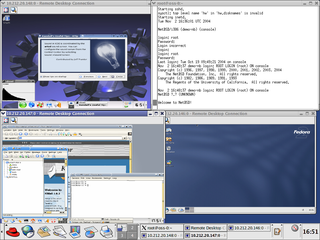
Citrix Systems, Inc. is an American multinational cloud computing and virtualization technology company that provides server, application and desktop virtualization, networking, software as a service (SaaS), and cloud computing technologies. Citrix claims that their products are used by over 400,000 clients worldwide, including 99% of the Fortune 100 and 98% of the Fortune 500.
Independent Computing Architecture (ICA) is a proprietary protocol for an application server system, designed by Citrix Systems. The protocol lays down a specification for passing data between servers and clients, but is not bound to any one platform. Citrix's ICA is an alternative to Microsoft's Remote Desktop Protocol (RDP).
Virtual PC is a discontinued x86 emulator for PowerPC Mac hosts and a hypervisor for Microsoft Windows hosts. It was created by Connectix in 1997 and acquired by Microsoft in 2003. The Mac version was discontinued in 2006 following the Mac transition to Intel, while the Windows version was discontinued in 2011 in favour of Hyper-V.

Xen is a free and open-source type-1 hypervisor, providing services that allow multiple computer operating systems to execute on the same computer hardware concurrently. It was originally developed by the University of Cambridge Computer Laboratory and is now being developed by the Linux Foundation with support from Intel, Citrix, Arm Ltd, Huawei, AWS, Alibaba Cloud, AMD, Bitdefender and epam.
Remote Desktop Protocol (RDP) is a proprietary protocol developed by Microsoft Corporation which provides a user with a graphical interface to connect to another computer over a network connection. The user employs RDP client software for this purpose, while the other computer must run RDP server software.

A diskless node is a workstation or personal computer without disk drives, which employs network booting to load its operating system from a server.
Microsoft Virtual Server was a virtualization solution that facilitated the creation of virtual machines on the Windows XP, Windows Vista and Windows Server 2003 operating systems. Originally developed by Connectix, it was acquired by Microsoft prior to release. Virtual PC is Microsoft's related desktop virtualization software package.
Application virtualization is a software technology that encapsulates computer programs from the underlying operating system on which they are executed. A fully virtualized application is not installed in the traditional sense, although it is still executed as if it were. The application behaves at runtime like it is directly interfacing with the original operating system and all the resources managed by it, but can be isolated or sandboxed to varying degrees.
The following is a timeline of virtualization development. In computing, virtualization is the use of a computer to simulate another computer. Through virtualization, a host simulates a guest by exposing virtual hardware devices, which may be done through software or by allowing access to a physical device connected to the machine.
Desktop virtualization is a software technology that separates the desktop environment and associated application software from the physical client device that is used to access it.
Microsoft Application Virtualization is an application virtualization and application streaming solution from Microsoft. It was originally developed by Softricity, a company based in Boston, Massachusetts, acquired by Microsoft on July 17, 2006. App-V represents Microsoft's entry to the application virtualization market, alongside their other virtualization technologies such as Hyper-V, Microsoft User Environment Virtualization (UE-V), Remote Desktop Services, and System Center Virtual Machine Manager.
Adaptive Internet Protocol (AIP) is a multi-channel protocol that allows an application running on any of multiple platforms to be displayed on any of a wide range of client systems. It supports rich remote display and input services with a number of display options to deliver the presentation of the remote applications onto the local display either as a standalone window, or within a contained remote environment delivered full-screen or in a standalone window. The protocol also supports audio, printing, and other device mapping services.
Ericom Software, Inc. is a Closter, New Jersey-based company that provides web isolation and remote application access software to businesses.
Remote Desktop Services (RDS), known as Terminal Services in Windows Server 2008 and earlier, is one of the components of Microsoft Windows that allow a user to initiate and control an interactive session on a remote computer or virtual machine over a network connection. RDS was first released in 1998 as Terminal Server in Windows NT 4.0 Terminal Server Edition, a stand-alone edition of Windows NT 4.0 Server that allowed users to log in remotely. Starting with Windows 2000, it was integrated under the name of Terminal Services as an optional component in the server editions of the Windows NT family of operating systems, receiving updates and improvements with each version of Windows. Terminal Services were then renamed to Remote Desktop Services with Windows Server 2008 R2 in 2009.

2X Software was a Maltese software company specializing in virtual desktop, application virtualization, application delivery, Remote Desktop Services, remote access and Mobile Device Management. On 25 February 2015, 2X Software was acquired by Parallels, Inc. The 2X products, Remote Application Server and Mobile Device Management, are now included in Parallels' offering.
Citrix Virtual Apps is an application virtualization software produced by Citrix Systems that allows Windows applications to be accessed via individual devices from a shared server or cloud system.
Citrix Cloud is a cloud management platform that allows organizations to deploy cloud-hosted desktops and apps to end users. It was developed by Citrix Systems and released in 2015.
Citrix Virtual Desktops is a desktop virtualization product.



